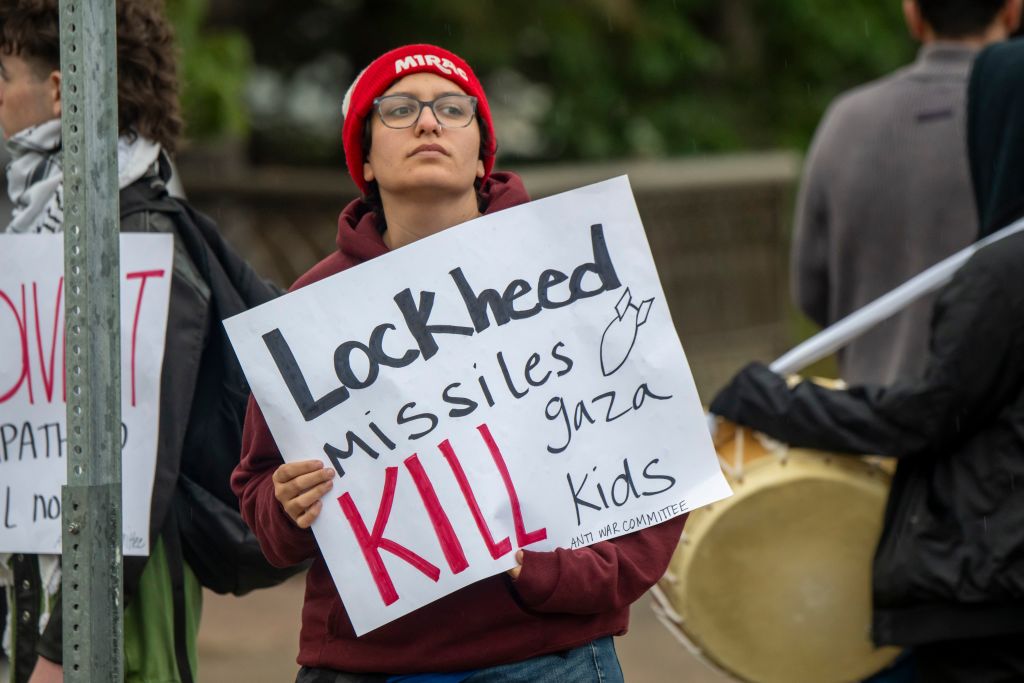In the wake of Hamas’s deadly attacks on Israel on Oct. 7, the Israeli government has declared war on Hamas, dropping more than 6,000 bombs on Gaza. From the Gaza strip, Hamas militants have fired more than 7,000 rockets at Israel, many of which have been intercepted by the Iron Dome, Israel’s extensive air-defense system.
As Israel races through its stockpiles of ammunition and air defense interceptors, it will be heavily dependent on longstanding U.S. support to replenish its stockpiles. The U.S. has promised to surge its military support for Israel, even as criticisms mount over the Biden administration’s failure to prevent the biggest recipient of U.S. military aid from causing significant civilian casualties in its offensive.
Here’s what to know about the U.S.’s military support for Israel and how it is being used in Gaza.

What support does the U.S. provide to Israel?
Israeli equipment and defense material will be resupplied based on their burn rate—the speed at which they are used in the ongoing military operations, says R. Clarke Cooper, former Assistant Secretary of State for Political-Military Affairs, the bureau which oversees arms transfers. The U.S. has already committed to sending Iron Dome air-defense missiles, small diameter bombs and JDAM kits, which convert unguided bombs into GPS-guided weapons to Israel. Boeing is reportedly speeding up the delivery of as many as 1,800 JDAMs, which the company produces in St. Charles, Missouri. These replenishments will come on top of previously agreed upon deals for advanced weaponry such as F-35 fighter jets, CH-53 heavy-lift helicopters, and KC-46 aerial refueling tankers, Cooper says, currently a non-resident senior fellow at the Atlantic Council.
The Biden administration has also asked for an additional $14 billion for Israel from Congress. This request is focused on providing air and missile defense support, and replenishing U.S. military stockpiles given to Israel. While there is overwhelming bipartisan support for the Israel aid, it is paired in the administration’s proposal with more than $60 billion for Ukraine, which faces stiff opposition from some Republicans in Congress.
Read More: The Arabic Word Thakla Speaks to Gaza’s Grief. There’s No English Equivalent
Whatever further aid is provided to Israel, it will come on top of decades-long military support for the country, which has helped make the IDF one of the most capable armed forces in the world. Since Israel’s founding in 1948, the U.S. has provided Israel with more than $130 billion in security assistance, more than the U.S. has provided to any country in the world. The U.S. currently supplies Israel with approximately $3.8 billion in security assistance annually.
For decades the purpose of this military support has been to provide Israel, the U.S.’s closest ally in the region, with a “qualitative military edge” over neighboring militaries. The result of this long-standing support has been an Israeli defense sector that is “defined by U.S. assistance and U.S. equipment,” says Elias Yousif, an expert in U.S. arms transfers at the Stimson Center, a Washington, D.C.-based think tank, while also emphasizing that Israel has developed a robust defense industry of its own. U.S. foreign military financing currently covers approximately 16% of Israel’s defense budget.

Are U.S. weapons being used in Gaza?
As human rights groups voice their concerns about the civilian cost of Israel’s military operation in Gaza, the U.S.’s part in sustaining the IDF is increasingly being questioned.
Because of the U.S.’s unique role in supporting Israel militarily, “The United States bears a special responsibility to ensure its assistance does not contribute to devastating civilian harm and possible violations of international humanitarian law,” says Annie Shiel, U.S. advocacy director at the Center for Civilians in Conflict.
“Public perception is that the United States is part of this military campaign,” says Michael Hanna, U.S. program director at the International Crisis Group. “You could be on the hook for a lot of bad things coming down the pipe. So that has to be something that concerns the administration.”
On Oct. 30, Pentagon Spokesperson Sabrina Singh said that the U.S. is not putting any limits on how Israel uses U.S.-provided weapons in its war against Hamas. Even so, officials including Secretary of State Antony Blinken have said that they are in contact with their Israeli counterparts about the need to minimize civilian harm.
Read More: Josh Paul on Why He Resigned From the State Department Over Arms to Israel
Among the weapons provided to Israel, “the transfer of 155mm artillery shells to Israel are of particular concern given the inevitable harm to civilians that comes with the use of explosive weapons in densely populated areas,” says Shiel. The artillery shells, which are also being used extensively in the trench warfare in Ukraine, are deadly in a radius of 100 to 300 meters, according to Oxfam.
The lack of access to Gaza makes it hard to track specifically what munitions the IDF is using in Gaza, arms experts say. But most experts agree that it is highly likely that U.S.-origin weapons are being used in the conflict. “I think it's a safe assumption to say that U.S. weapons are being used extensively in the current Israeli operations in Gaza,” says Yousif.
In the past, human rights organizations have said that U.S. military equipment has been used in Israeli military operations during which civilians were killed, in locations without evident military targets in the vicinity. In 2021, Human Rights Watch claimed that U.S.-made weapons were used in at least two such attacks that may have violated the laws of war.
More Must-Reads from TIME
- Donald Trump Is TIME's 2024 Person of the Year
- Why We Chose Trump as Person of the Year
- Is Intermittent Fasting Good or Bad for You?
- The 100 Must-Read Books of 2024
- The 20 Best Christmas TV Episodes
- Column: If Optimism Feels Ridiculous Now, Try Hope
- The Future of Climate Action Is Trade Policy
- Merle Bombardieri Is Helping People Make the Baby Decision
Contact us at letters@time.com